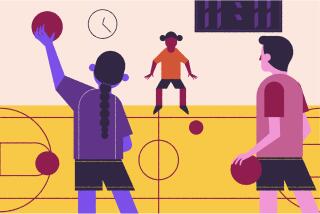Urban areas make a Little progress
SOUTH WILLIAMSPORT, PA. -- — Leaning against a dugout wall at Lamade Stadium, 12-year-old Evell Nelson’s eyes lit up as he thought about the future.
An early season tournament for urban Little League programs from around the country didn’t satisfy the slugger from Seattle.
“We all want to come back here to play in the Little League World Series,” the third baseman said.
Once considered a weakness of Little League Baseball, inner-city and urban organizations such as the Seattle Central league are growing -- a bright spot for a youth program that, overall, has seen a 13% decline in participation over the past decade.
As Little League looks for ways to reverse declines, mainly in suburban and rural areas, leaders view the “Urban Initiative” program as an avenue to get more children -- especially minorities and the poor -- to pick up a glove and ball.
Little League boasts that the 9-year-old program has helped nearly 1,100 leagues and 3,900 teams, which amounts to about to 50,000 players.
Little League does not track how many of the assisted leagues are still in operation, or are not with Little League but still playing baseball. For instance, a local league could choose to join another organization such as the Babe Ruth League.
But officials say the majority of Urban Initiative-assisted programs are still with Little League. Through the program, leagues can apply for grants to help with costs such as equipment and field renovations.
“The point of the Urban Initiative [is] these kids, living in some pretty tough parts of the country, are really just being denied the opportunity,” said Little League president Stephen Keener, his eyes darting across the field watching plays during the Memorial Day weekend tournament for urban teams.
“A lot of the rural, suburban programs, kids may not choose to play for a number of reasons,” Keener said. “Many of these kids don’t have the choice, because no program existed for them.”
Corporate donations and grants fund the program. Eligible leagues get “assistance packages” that help local volunteers.
Over the years, Bank of America has provided more than $500,000 for field renovations. American Honda has given $100,000 annually for equipment and uniforms. A $1 million grant from the Conrad Hilton Foundation has helped build new fields.
It’s unclear how the recession will affect future funding, though Urban Initiative director Demiko Ervin said he remained confident the program would keep going.
A $5,000 grant from Little League went to help pay for equipment for the Seattle Central league. Government grants helped pay for new batting cages that cost $60,000.
All for an organization that Seattle Central league president Steve Orser said was nearly defunct a decade ago after the program had “lost its direction.”
Reinvigorated six years ago with fresh leadership and a new army of volunteers, the number of players has grown from 30 to more than 400. All the nearly three dozen teams are named after Negro League squads.
It’s presented Orser with some welcome dilemmas.
“At some point, we’re going to have to cap it,” he said in a phone interview. “We’re running out of fields, equipment and supplies.”
A league in Memphis, Tenn., started through Urban Initiative in 2008 already fields 20 teams with 320 players. Organizers in Lancaster, Pa., launched a city league two years ago to cater to its urban population because another area league concentrated more on outlying areas.
The Lancaster league has about 120 players, up from 50. Grants helped pay for scholarships, and separate grants from Major League Baseball helped repair fields that league president Audrey Landers likened to “chunks of grass” and mud.
“We could reach the population we wanted,” Landers said.
Like 10-year-old Craig Bouder Jr., a diminutive pitcher who looked as if he could fit a second player into his baggy red Lancaster uniform. He bounded off the mound and got high-fives from teammates after getting out of a first-inning jam against Seattle.
“It’s awesome,” he said about his Williamsport experience. “We’re seeing people that we probably won’t ever see again.”
Overall, the number of children playing Little League baseball has declined from nearly 2.6 million worldwide at its peak in 1997 to about 2.2 million in 2008.
Suburban and rural leagues still make up the vast majority of Little League’s programs.
Some of the decline, organizers say, is due to leagues switching to other youth baseball organizations or teams choosing to play more “travel ball” tournaments instead of within the Little League structure.
Those options may not be as available in urban areas, organizers say.


